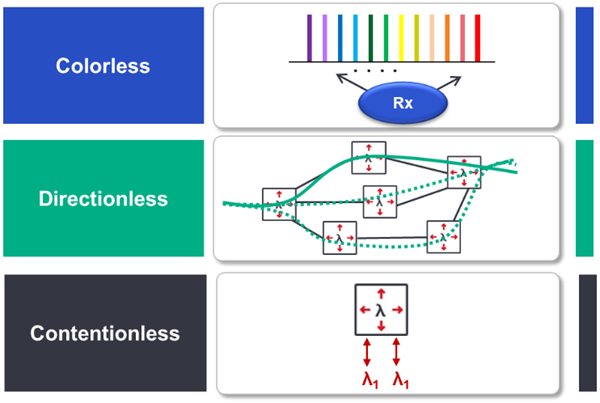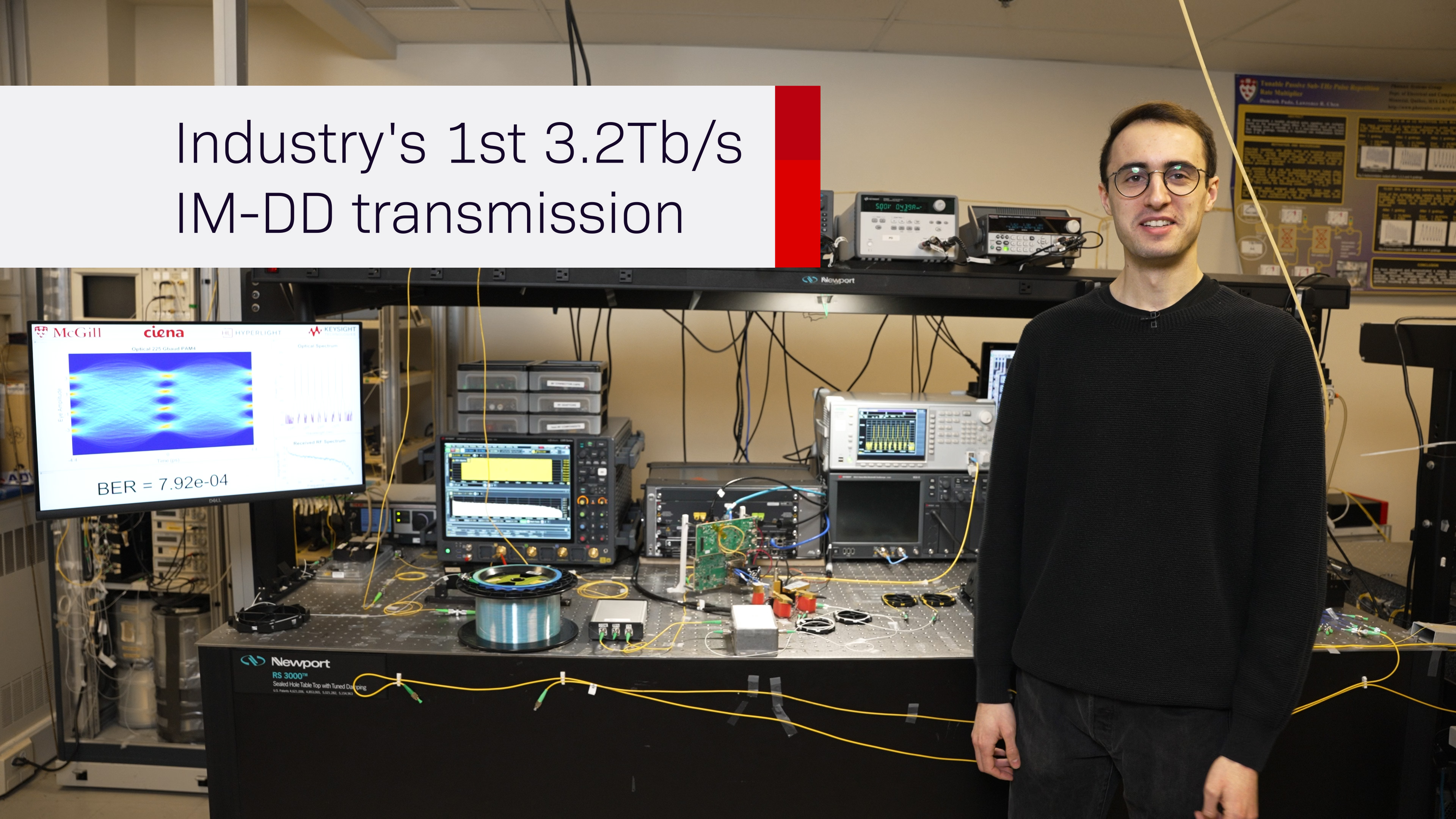Understanding why CDC with flexible grid is so popular for next-gen networks
It was not long ago that the industry’s first programmable 400G technology hit the market and with it came an overwhelming feeling about what would be required to transport 400G waves across the network. Fast forward and the journey towards a more programmable infrastructure that leverages a flexible grid, reconfigurable photonic layer foundation is underway. This evolution may still seem daunting, but the result will allow operators to maximize efficiencies through new levels of agility, increased automation and simplified operations.
As explained in a recent blog, enabling a fully agile photonic layer begins with the underlying ROADM (Reconfigurable Add-Drop Multiplexer) architecture, that is used to add, block, pass or redirect wavelengths at each site. Colorless-Directionless-Contentionless (CDC) and flexible grid (CDC-F) ROADMs are fundamental elements of the next-gen photonic layer. These capabilities can be deployed on their own but when they are deployed together, they provide the highest degree of agility and flexibility so that operators reduce OPEX, turn-up services faster and increase system optimization.
So let’s take a step back and understand why CDC-F are such popular building blocks of the next-gen photonic layer, their value and the benefits that operators can count on as a result.
 Classic ROADMs are limited by fixed wavelength assignments to specific add/drop ports. This means that changing the frequency or color of a wavelength requires a site visit to rewire the wavelength to the desired port. This problem is eliminated with Colorless functionality that enables any wavelength (of any color) to be added/dropped on any port. Operators can remotely reconfigure wavelengths without site visits, by simply tuning the transponder to the desired wavelength frequency.
Classic ROADMs are limited by fixed wavelength assignments to specific add/drop ports. This means that changing the frequency or color of a wavelength requires a site visit to rewire the wavelength to the desired port. This problem is eliminated with Colorless functionality that enables any wavelength (of any color) to be added/dropped on any port. Operators can remotely reconfigure wavelengths without site visits, by simply tuning the transponder to the desired wavelength frequency.
Directionless is the ability to remotely route wavelengths across any viable path in the network. Without this capability, changing the direction of a specific wavelength requires a technician to physically rewire the transponder connection in the desired connection. Having directionally independent ROADMs are an important requirement to leverage L0 control plane for photonic restoration enabling a highly-resilient, programmable network foundation that can support changing service requirements.
A Colorless and Directionless (CD) ROADM provides important benefits along with some flexibility, however, it does not solve the problem of wavelength contention. Contentionless ROADMs eliminate wavelength blocking so that operators can add or drop the same wavelength at the same add/drop structure. Together the capabilities of Colorless, Directionless and Contentionless (CDC) are what provide ultimate flexibility at the optical layer required for a fully agile photonic architecture.
Evolving to a fully agile photonic infrastructure will not happen overnight but is a critical step to take if operators want to take full advantage of the significant cost and power savings benefits enabled by new coherent technology. Moving forward, optical networks will be required to support a mix of existing and higher speed coherent interfaces, which requires a gridless, reconfigurable photonic layer.
Gridless (or flexible grid) ROADMs have two key benefits:

First, they future-proof the network by providing the ability to right-size channels to be able to accommodate the larger passband of higher symbol rate coherent modems (that require more than 50GHz of spectrum). This enables operators to accommodate speeds beyond 400G for example on the same network that is already carrying 100G to 400G wavelengths.

The second important benefit is improved spectral efficiency. With a gridless architecture, operators can squeeze channels together more closely than ever to occupy the least amount of spectrum (a technique widely used in submarine systems today). To take advantage of these benefits, operators have already been deploying gridless-capable hardware in their fixed grid systems, such that flex-grid functionality can be turned on via software when it is required.
Here are some specific examples of the key benefits derived today with a flexible, intelligent and programmable optical infrastructure:
- A CDC-F infrastructure facilitates wavelength re-grooming to increase service availability with optical restoration or to perform proactive network maintenance in a condensed maintenance window with fewer truck rolls. We recently announced that with their CDC-F architecture and L0 control plane capabilities, QTNet can now benefit from the highest resiliency against potential network/fiber failures as well as protect their customer’s traffic from natural disasters, such as typhoons, torrential storms and earthquakes which impact the island of Kyushu, Japan.
- The ability to quickly respond to capacity needs with automated end-to-end service provisioning is a key differentiator in today’s competitive environment. With a CDC-F infrastructure, operators can remotely route wavelengths across any viable path in the network without having to drive to remote sites to insert cards or cabling. Today cloud providers prefer to deploy a CDC architecture to be able to automate end-end provisioning via software without having to worry about wavelength blocking.
- As the optical network continues to evolve operators can deploy CDC-F with the power of analytics and intelligence to drive real-time, pro-active system optimization to extract the most value from existing network resources. Southern Cross Cables is deploying this capability to significantly enhance the scale, programmability and intelligence of their network so that it can quickly adapt and respond, in real-time to changing and unexpected user demands.
Today cloud providers prefer to deploy a CDC architecture to be able to automate end-end provisioning via software without having to worry about wavelength blocking.
Although the idea of evolving to a flexible grid and reconfigurable photonic layer comprised of CDC-F building blocks can be overwhelming, the sophisticated photonic software control that is now available eliminates complexity and enables a simple transition. For example, operators can convert their fixed grid system to a flexible grid system, in-service. And this transition does not mean that all the ROADM nodes in the optical network should be converted to CDC-F, but rather that converting some nodes to CDC-F can provide important benefits, such as significantly improving spectral efficiency when they are strategically deployed at higher add/drop sites.
No matter where you are in the journey towards a more programmable infrastructure, it is clear that there is a growing need for a flexible grid, reconfigurable photonic layer foundation that leverages the latest coherent technology with increased automation to quickly adapt to meet changing customer expectations.







